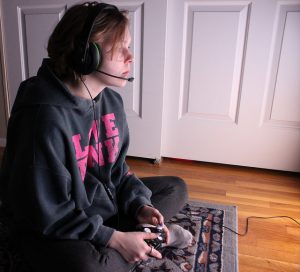Porn Hub is the 10th most visited website in the world, and #3 in bandwidth use, behind Google and Netflix. It’s had an explosion in traffic since Covid 19 put us all under lockdown with too much time in front of our screens. Teens are watching too, but YOU (the parent) have no idea how much: “Research demonstrates that parents are, for the most part, unaware of their children’s porn usage, with half of parents unaware their teens had seen pornography and teens having seen up to 10 times more pornography than their parents believe. Parents especially underestimated their teen’s exposure to extreme content, such as violent porn, which is just as easy to access as traditional pornography content” (quote from this article). For some time, a woman named Laila Mickelwait has tried to get the world to pay attention to the dangerous and illegal activity on the site, including starting an online petition to shut it down that now has over 2 million signatures. Finally, the New York Times was spurred to investigate, and found that the worst imaginable kinds of exploitation were to be found on Pornhub. This led to Canadian company, MindGeek, the owner of the site, taking down 13 million videos, leaving 3 million. In addition, Visa, Mastercard and Discover Card will no longer process payments for purchases  on the site. A lawsuit by 40 victims was filed in December, and now a Canadian government Ethics Committee is (this week) hearing testimony from victims, including a girl who was as a 7th grader persuaded by a boy she had a crush on to send a naked picture, which ended up on Pornhub. Her saga has been covered by Dr. Oz, in a must-watch video (must-watch WITH your teen, that is, to warn them about the consequences of sexting). Her story shows how a single moment of weakness can lead to years of emotional torture and public exploitation through sites like Pornhub that allow posting of content without consent, and are infested with illegal pictures and videos such as those showing the actual rape and assault of both adults and children.
on the site. A lawsuit by 40 victims was filed in December, and now a Canadian government Ethics Committee is (this week) hearing testimony from victims, including a girl who was as a 7th grader persuaded by a boy she had a crush on to send a naked picture, which ended up on Pornhub. Her saga has been covered by Dr. Oz, in a must-watch video (must-watch WITH your teen, that is, to warn them about the consequences of sexting). Her story shows how a single moment of weakness can lead to years of emotional torture and public exploitation through sites like Pornhub that allow posting of content without consent, and are infested with illegal pictures and videos such as those showing the actual rape and assault of both adults and children.
Teens’ YouTube Screen Time is Through the Roof
“Kids spend more time with media and technology than they do with their parents, time in school, or any other thing. They are literally living in a 24/7 media and technology world,” says James Steyer, founder and CEO of Commonsense Media about a 2019 survey of (non-homework) teen screen use. The number 1 activity is watching videos, with YouTube being their first choice, and actual TV watching dropping dramatically in even just the last 4 years. This means that families are not watching together, you can’t walk into the room and see what TV show your kids are watching, and therefore you probably have no clue WHAT they’re watching.
 Wouldn’t you LIKE to know what your child is filling their eyes and mind with all those hours every day? Commonsense Media has a great place to start getting educated with their Parents’ Ultimate Guide to YouTube .
Wouldn’t you LIKE to know what your child is filling their eyes and mind with all those hours every day? Commonsense Media has a great place to start getting educated with their Parents’ Ultimate Guide to YouTube .
If you discover that some things they’re accessing (or that they could access) are troublesome, you may want to check out this parental control guide to setting restrictions using YouTube settings.
Videos by teens, for teens
I recently came across the OK, Inc. YouTube channel, with dozens of videos on topics teens say they want addressed…things such as date rape, bullying, sexting, abusive relationships, substance abuse, etc. These videos use high school students as actors and portray realistic scenarios. I watched several that have been viewed by millions, and can recommend them as excellent tools for parents and teachers.
These short story videos help teens recognize risky situations, make good choices, deal with consequences, and see a way forward even after making a poor choice. Every video has an example of friends who help their friends along the way. Parents, don’t we want to see our child learn now how to have good relationships, choose well when faced with negative pressures, and to BE a good, supportive friend to others who are caught in bad decisions, or bad relationships? Sometimes, all the good advice we know we could give is better received coming from peers. These videos provide a creative way to open conversations with our children about the pressures and problems they face in everyday life, without coming across as too “preachy.” I urge you to watch and discuss as many of these videos with your teens as possible.
after making a poor choice. Every video has an example of friends who help their friends along the way. Parents, don’t we want to see our child learn now how to have good relationships, choose well when faced with negative pressures, and to BE a good, supportive friend to others who are caught in bad decisions, or bad relationships? Sometimes, all the good advice we know we could give is better received coming from peers. These videos provide a creative way to open conversations with our children about the pressures and problems they face in everyday life, without coming across as too “preachy.” I urge you to watch and discuss as many of these videos with your teens as possible.
Should I be concerned about Fortnite?
 Fortnite is the game every teen is talking about. It’s a multi-player shooter survival game (Mac, PlayStation 4, Windows, Xbox One, IOS app, and soon on Android), with free and paid versions. The obvious violence (it’s about killing with weapons after all) is not graphic–no blood or gore. It is “cartoonish” rather than realistic. No sex, no nudity, although the bodies of the female characters are exaggeratedly curvy. One article explains why it’s so popular with kids: “Well, it’s free, it’s fun and it has a very silly, offbeat sense of humour. While PUGB has a serious, realistic visual style, Fortnite: Battle Royale has very bright, almost cartoon-like graphics as well as loads of ridiculous items and costumes, such as space suits and dinosaur outfits. You can also pull a variety of dance moves during the game, and some of these have taken on a cult appeal in schoolyards around the globe.”
Fortnite is the game every teen is talking about. It’s a multi-player shooter survival game (Mac, PlayStation 4, Windows, Xbox One, IOS app, and soon on Android), with free and paid versions. The obvious violence (it’s about killing with weapons after all) is not graphic–no blood or gore. It is “cartoonish” rather than realistic. No sex, no nudity, although the bodies of the female characters are exaggeratedly curvy. One article explains why it’s so popular with kids: “Well, it’s free, it’s fun and it has a very silly, offbeat sense of humour. While PUGB has a serious, realistic visual style, Fortnite: Battle Royale has very bright, almost cartoon-like graphics as well as loads of ridiculous items and costumes, such as space suits and dinosaur outfits. You can also pull a variety of dance moves during the game, and some of these have taken on a cult appeal in schoolyards around the globe.”
I always urge parents to check out games, videos, etc. on Commonsense Media, and I also found a Good Morning America video discussing the game, its addictive qualities and how to set limits…things most parents are concerned about.
Be THAT parent…
 Controlling and/or monitoring your teen’s internet use is not an intrusion into your child’s privacy.
Controlling and/or monitoring your teen’s internet use is not an intrusion into your child’s privacy.
Wait…yes it is! But it’s NECESSARY. As parents, we’d throw ourselves in front of a speeding car to push our precious child out of the path of harm. In the same way, it’s our job, even duty, to both warn and protect our children from the darker things they can be exposed to on their phones, tablets and laptops. Even if it’s just making sure that gaming doesn’t chew up too much family or homework time, we have an interest in keeping track of what our teens are doing on the internet. There’s no one-size-fits-all software solution. But pcmag.org does have an up-to-date resource page with alternatives for monitoring and/or controlling internet use by your child.
Watching This With Your Teen is Better Than Any Lecture
Even if your teen isn’t old enough to drive yet, he or she may be in the car with other teens who drive. And, shall we admit it, many of us have caught ourselves responding to that “ding” when we are driving as well. Watching this short (under 4 minutes, not graphic) YouTube video together with your family will have a more powerful impact than any lecture or set of statistics you can give them, although the facts are indeed frightening. An online article by Teen Vogue relates that “Eleven teenagers die every day as a result of texting and driving…. Almost 330,000 injuries every year are due to accidents caused by texting and driving. 1.6 million crashes are a result of it, as well. And 21% of teen drivers involved in fatal crashes were — you guessed it — using their cell phones behind the wheel.”
YouTube video together with your family will have a more powerful impact than any lecture or set of statistics you can give them, although the facts are indeed frightening. An online article by Teen Vogue relates that “Eleven teenagers die every day as a result of texting and driving…. Almost 330,000 injuries every year are due to accidents caused by texting and driving. 1.6 million crashes are a result of it, as well. And 21% of teen drivers involved in fatal crashes were — you guessed it — using their cell phones behind the wheel.”
If you have trouble with the link above, here it is to cut and paste: https://youtu.be/E9swS1Vl6Ok
A reminder about subtle sexism
Once again, I am setting aside my distaste for marketing and commercials to share a video (okay, an ad) that at least highlights a good point. If you have sons, I especially encourage you to share this with them as part of a conversation about the subtle ways sexism can creep into everyday life.
I want this PSA in my state!
I was driving down a major road in our town this weekend when I pulled up next to a car in which the driver was holding her pink smartphone with the same hand as she held the steering wheel, right up at dashboard level. She was actively staring at the screen, scrolling and typing. Feeling guilty myself anytime I take a call without a hands-free headset, I was appalled at this blatant disregard for common sense, safety, and Illinois’ new ban on all texting and handheld phone use while driving. Okay, I reasoned, we’re at a stoplight. And I suppose she could be looking at a GPS map.
But no, as the light turned green, the scrolling and taping motion told me she was not looking at a map, nor did she have any intention of putting the phone down. We stayed pretty level with each other and stopped at two more lights together before she eventually sped away, and any time I glanced over, her posture and the scrolling and tapping hadn’t changed.
Yes, I admit, I am judging her. I would love to be wrong, but I have a very hard time not seeing her as a danger to myself, my children, and everyone else on the road. Because for any of us, it is only a matter of time before our distraction behind the wheel hurts someone.
Which leads me to the PSA I just saw, shared by the website Upworthy. (The PSA is from Volkswagen and was posted by MadOverAds.)
Please, parents, set the example for your children and define a standard of zero tolerance for phone use while driving. Not only is it the law in Illinois, it is unquestionably a matter of safety for your children and for others. I get the temptation — I have to discipline myself frequently to ignore the buzzes and pings coming from my phone while driving. And I have been the passenger with friends, my husband, even my father as the driver started using the phone to look up a restaurant or answer a text (at which point I grab the phone and do it for them). The point is, none of us are good enough drivers to get away with it forever. We simply cannot allow ourselves or those we love to fall to the temptation to use the phone while driving, even “just this once.”
Talk About Real Beauty with Your Children
In recent years, Dove has tried to create a niche for itself by promoting real beauty and self-esteem. Granted, it still sells beauty products, and what I am sharing in this post is still an ad, but it provides a helpful reminder, nonetheless. Warning — if you try to avoid images of scantily clad women, this video is not for you.
(Video from link here.)
We are all impacted by advertising, and now part of parenting is helping your children sift through advertising’s messages. It’s a tough job, but it is necessary. Here are some activities and conversations to try with your kids (boys and girls):
– Pick a time to do an “ad purge” of your house. Make a competition to see how many ads or examples of marketing your kids can find throughout the house. (If you want to de-clutter at the same time, throw away or recycle as much as you can.) Examples of what you might find: magazines, catalogs, political mailings, all forms of product packaging, coupons, in-app ads on mobile devices, TV, radio, the backs of books, and the list goes on.
– Collect several examples of health and beauty products in your house. Read the packaging, front and back, with your kids. How does it sound? Do you believe it? Is it scientific sounding or fanciful? For younger kids, ask them to write packaging for a beauty product that they invent and talk about it. For older teens, ask them how they select which products they will use.
– Pick a day to go without make-up as a family. I’ve known whole schools to make a no-make-up day, encouraging teachers and students alike to show their bare face to world. Talk about whether make-up is easy or difficult to give up.
What other ideas can you think of for encouraging your kids to see real beauty?
